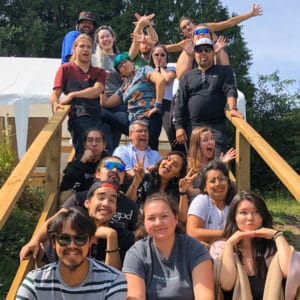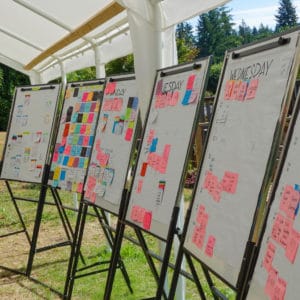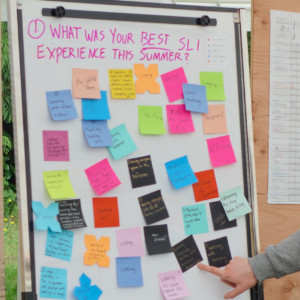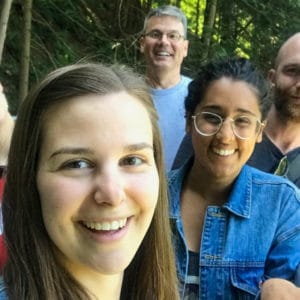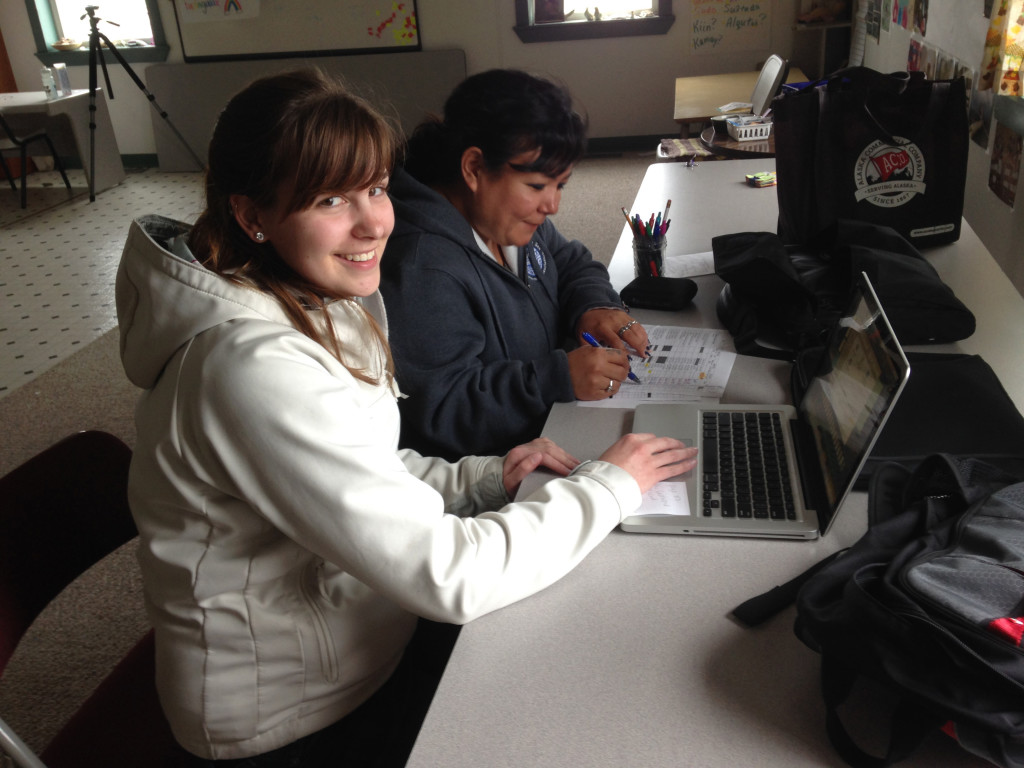
Very early in the summer Evan mentioned to me that there were some Unangam Tunuu books that had been read by speakers but to date no one had figured out how to, or at least had not gotten around to, combining the audio with the scanned copies of the books. This meant that anyone wanting to listen to the book and view it at the same time had to have multiple applications open, which was a rather clunky process. I made an offhanded comment that it was possible to combine images with an audio file in Powerpoint, and the next thing I knew I had volunteered myself to oversee the project. But it was not the simple task I (nor anyone else) had originally envisioned.
The first real roadblock was just finding and organizing all of the files so we could begin the project. Janette, the tech expert from the local team, Evan, and I spent several hours figuring out how many books existed, what we had copies of, and what audio existed in original and edited versions. This was the beginning of the tracking for the books.
Once we had this sorted out I first made one book into a movie in Powerpoint, which took roughly an hour, but when I tried to export it as a movie the quality was terrible. Sky then suggested that I could combine the audio file and images in iMovie to make a better quality film. So I scrapped the Powerpoint project and learned how to use iMovie. Immediately I ran into our first problem, I could not import PDF files, only JPEG. After some internet searching I learned how to make my own app on a Mac to convert PDF files into JPEG. Phew, crisis averted. I made the movie and it turned out great. Now we were off to the races.
I was not going to be the only one creating movies though, so I was tasked with creating some instructions on how to do this so that I could teach three other members of the Summer Language Intensive team, Janette, Roxana, and Christina, how to do it. The next day I showed Janette and things were rolling along great, until we arrived at our second problem. The first book that Janette tried to create an iMovie for was missing the audio for an entire page of the book, and since we didn’t have the original audio (recorded in 1970’s) to check if that page had even been read there was nothing we could do to fix it. Instead we decided to record another speaker reading that page and edited it into the movie. As the “book project” progressed we encountered similar issues of missing audio and missing pages in the scanned versions of the books. In every case we were able to find the correct audio or rescan the book, but each issue caused some delay.
The third issue arose the very next day when I tried to create a movie on the iMac at the Civic Center. As I discovered quite quickly, the computer had not been updated to the newest software and as a result the instructions I had created did not work for the older version of iMovie. Since there is no internet at the Civic Center at all, and really limited internet on St. Paul in general, we also could not update it. To get the computer updated we would have had to box it up and ship it to someone in Anchorage who could update it and send it back. While that might sound unbelievable, my personal experience says that it’s not. I tried to do a software update on my computer this summer and after 13 hours it still hadn’t even begun initializing, and that was only a minor update. As a result this meant that the project had to be done on the WAYK team’s personal laptops which seriously slowed us down as we were all using our computers for other tasks. And meant that files had to be continually transferred between computers. Additionally, this means that no local member of the Summer Language Intensive can create more movies from books unless they find a way to update the Civic Center’s computer, learn how to use the older software on the computer that is less user-friendly, or get/have a personal computer with updated software.
After we had finished making all of the books we also realized that the introductions of the speakers reading the books had been cropped out of the audio. Since we wanted to make sure that we gave everyone involved the appropriate credit, Janette had to go back to the audio files she edited to find an introduction and crop it, and then we had to go back through and add it to each of the 29 movies, one by one. This led to a host of other issues because the audio files we had were very old and as a result were poor quality compared to what we would expect of audio created in 2015. On our second time through the books we realized that there were lots of noises from the recorder that were really disruptive to the movie viewing experience, so we decided to invest more time editing each audio file again in iMovie, even though they had all already been edited once by Janette in a special audio software called Audacity.
When we were about halfway through this process of adding intros and re-editing the audio it seemed like clear running to the finish line, but unfortunately there was one more problem standing in our way. We had decided that the books were a really great resource and that it would be nice to have a few videos of speakers reading the books so that you could see them flipping the pages and talking about the pictures. So we selected a few books and showed them to the two fluent speakers, Edna Floyd and Iliodor Philemonof, who had agreed to read them. As they read the very first book we showed them we could tell that something was wrong. Edna and Iliodor told us that the book didn’t make sense to them. So we decided to show them the rest of the books to see if any of them were useable. They read through all of the books and sorted them into piles of “good”, “good enough”, and “not good”. Whether because of dialect differences or errors, it seems that some of the books we had were incorrect, at least according to St. Paul and St. George dialect speakers. At first it was pretty discouraging to hear that some of the movies we had put hours into creating were not going to be used, but upon second consideration it really was much better to have discovered that the books were not right for St. Paul speakers before we began distributing them. We are also still hopeful that those books might be of use to speakers in the Aleutian chain, where the dialect is slightly different than St. Paul and St. George, but we are still investigating this.
As a result of the issues we kept encountering the book-to-movie conversion project took nearly quadruple the amount of time we had originally anticipated. In the end, creating 29 movies which we anticipated taking a week or so turned out to take, all told, at least a total man hour cost of 3000 hours to produce, which is an average of just over 100 hours per book. And this total only includes the time actually spent on the conversion from books to movies, which means to get a complete total you’d have to add several hours to account for the time it took to create each book and then to record it.
If there’s one sentence that really sums up the book-to-movie making project of the summer it would be this: “It wasn’t supposed to go down like this” – Evan Gardner. While it would have been great if the project had been simple and easy with no issues or errors, that almost never happens in real life, and definitely not in language projects. We learned several valuable lessons that can be applied in future WAYK projects, and in life in general. First, whenever possible always have speakers vet the resources that you are working with before you begin using them. There’s nothing like developing something or learning language from a book only to find out several weeks down the road that you wasted your time. Second, make sure that everyone involved has compatible technology. Some programs only work on particular devices or there are major differences between versions, so it’s easier to get technology organized before you begin. Thirdly, for future projects we now have a solid estimate as to the number of hours it takes to covert a book with audio to a movie. This is particularly helpful for writing grants and for planning purposes so that the correct number of hours and dollars can be devoted to the project. And lastly, perhaps the real takeaway for me anyways, is always know exactly what it is that you’re getting yourself into before you volunteer to take on a project, because what seems like a simple task that can be accomplished in a week might take you a month and a half.
Be sure to visit St. Paul’s Unangam Tunuu website, tanamawaa.com, to see more of the videos.
Post authored by Robyn.

